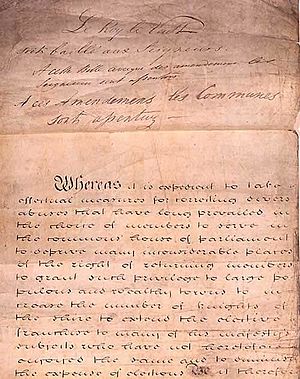La Reyne le veult facts for kids

"La Reyne le veult" ("The Queen wills it") or "Le Roy le veult" ("The King wills it") is a Norman French line used in the Parliament of the United Kingdom to show that a public or private bill has received Royal Assent from the Monarch.
History
The practice of giving Royal Assent came from William the Conqueror to show that the King intended for something to be made law. Norman French came to be used as the normal language of the educated classes and of the law, though Latin continued to be used with it. The work of the Parliament of England was conducted entirely in French until the latter part of Edward III's reign (1327–1377) and English was only rarely used before the reign of Henry VI (1422–61, 1470–71). Royal Assent was sometimes given in English, though more often in French. The practice of recording Parliamentary statutes in French or Latin stopped by 1488 and statutes have been published in English ever since.
During the period of the the Protectorate, when the Lord Protector (Oliver Cromwell and later his son Richard) governed the country, assent was given in English. The old practice of giving assent in Norman French was resumed following the Restoration in 1660 and has continued ever since. There has only been one attempt to remove it, when the House of Lords passed a bill in 1706 "for abolishing the use of the French tongue in all proceedings in Parliament and courts of justice." The bill failed to pass the House of Commons. Although the use of French in courts was later abolished in 1731, Parliament's practice was not affected.
Usage
The line is used to show that the Monarch has granted their Royal Assent to a bill in order to make it become law. It is used by the Clerk of the Parliaments in the House of Lords. It is only used after the Lord Chancellor with the Lords Commissioners, has read out the Letters patent for the bill. The Clerk of the Crown then reads out the short title of the bill and the Clerk of the Parliament responds by saying the line 19 times towards the House of Commons at the bar of the House. The line is also written on the paper of the bill to show that the Monarch granted Royal Assent to the bill.
The line has been used wrongly on other bills, same as the wrong line has also been used for government bills. There are a few occasions where this has happened, most notably on the Act of Supremacy 1558 where "Soit fait comme il est désiré", the line used for personal bills, was used instead of "La Reyne le veult".
If the Royal Assent is refused, the line "La Reyne / Le Roy s'avisera" would be used, though in practice no British monarch since Queen Anne has not given royal assent since a dispute over militia in Scotland in 1707.
Images for kids
-
Start of the parchment roll of the Reform Act 1832, with the clerk's record of the royal assent of King William IV written above the bill, reading in full Le Roy le Veult soit baillé aux Seigneurs. A cette Bille avecque des amendemens les Seigneurs sont assentuz. A ces Amendemens les Communes sont assentuz.


